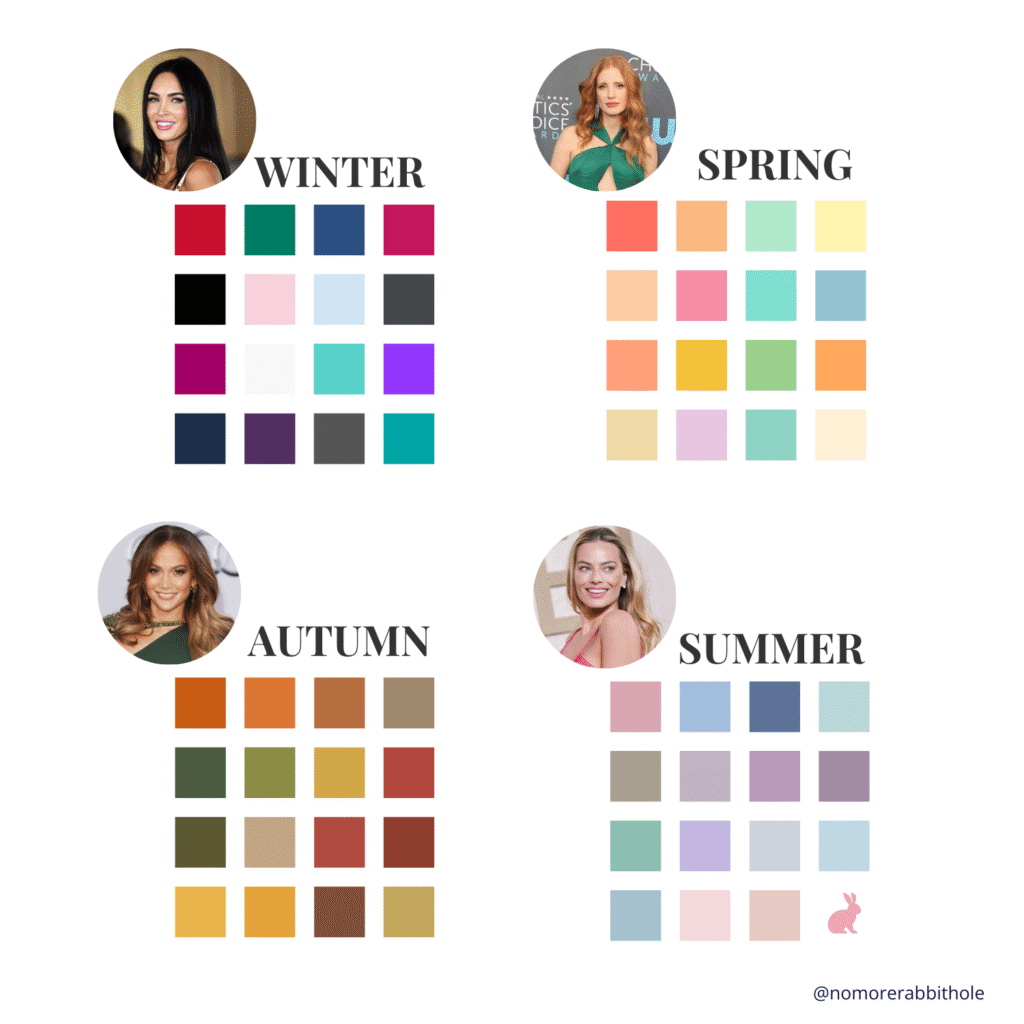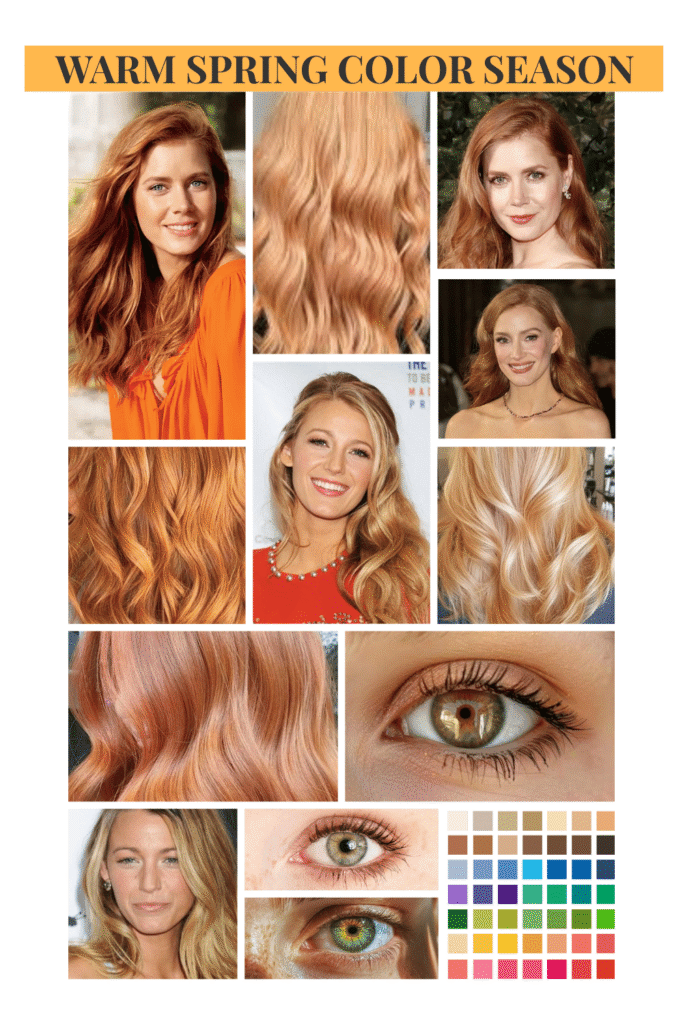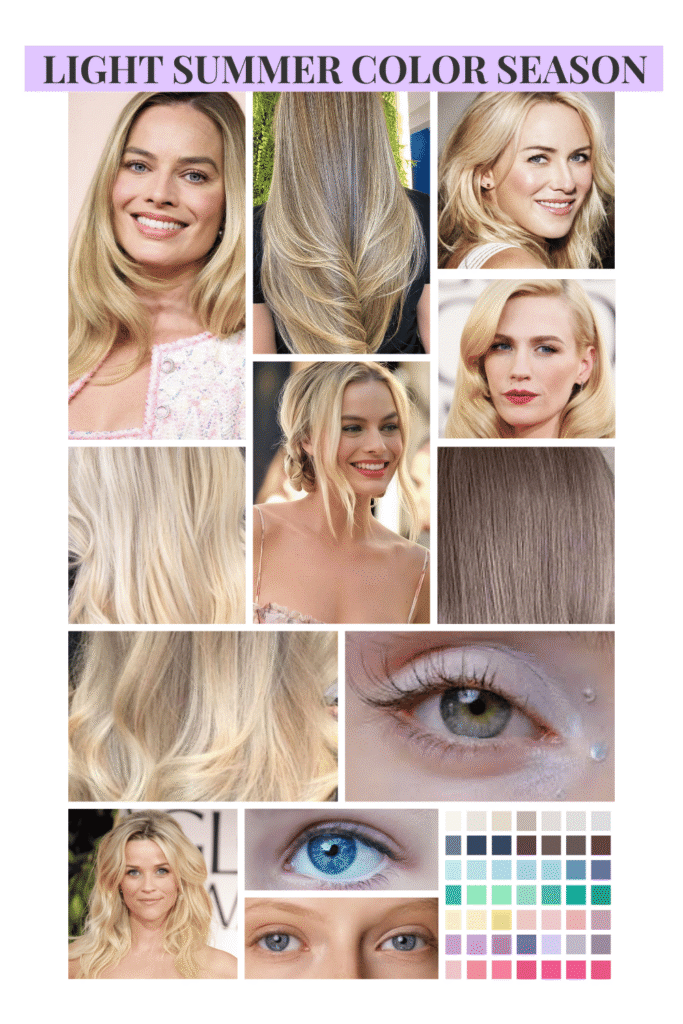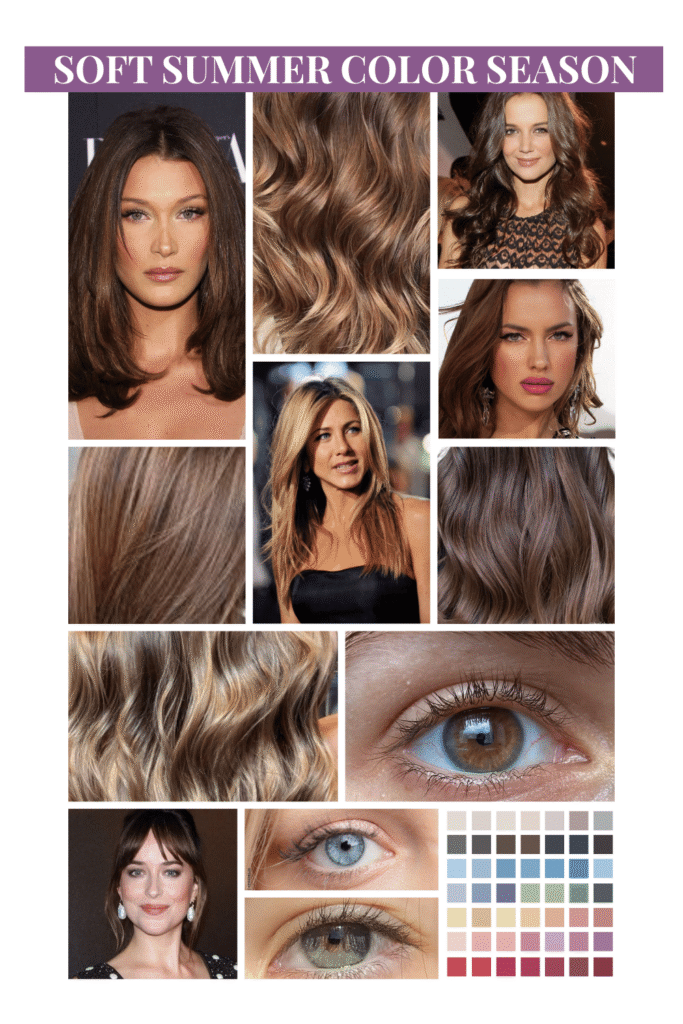Color Analysis Explained: The 4 Seasons & 12 Subtypes to Find Your Best Colors
Welcome to the world of Color Analysis! Have you ever noticed how certain colors make you radiant, while others drain your natural glow? Color Analysis helps you understand which hues best complement your features, empowering you to dress in ways that feel authentic and flattering.
In this article, I’ll explore the fundamentals of color typology, including the four main seasons of Color Analysis — Spring, Summer, Autumn, and Winter — and their 12 subcategories, which offer a more refined approach to finding your ideal color palette. Understanding color typology isn’t just about selecting the right clothing colors; it’s about making choices that enhance your natural beauty.
Let’s start with the key terms and principles of color typology.
Basic Terms of Color Analysis: What You Need to Know Before Finding Your Season
To understand color typology, you’ll need to familiarize yourself with these fundamental concepts:
Undertone:
Every color has an undertone — cool or warm. Cool undertones include blue, purple and green undertones. Warm undertones include red, orange and yellow.
Value (Lightness):
If the Value is high, the colors appear shining, while low Value makes them look deep, or shadowed.
Saturation (Intensity):
Saturation describes a color’s vibrancy. Highly saturated colors are bold and intense, while less saturated colors appear softer and more muted.

To categorize a color, we need to know at least two out of the three characteristics. If it can be categorized into two types, we place it in the one where the undertone matches.
- Winter: blue or purple undertone, bright, highly saturated
- Summer: blue or green undertone, shadowed, less saturated
- Autumn: red or orange undertone, shadowed, highly saturated
- Spring: orange or yellow undertone, bright, less saturated
The 4 Main Seasons: Spring, Summer, Autumn, Winter

Color Analysis classifies people into four main seasons based on their natural skin tone, hair color, and eye color. Here’s an overview:
Winter
- Hair: Usually dark brown or cool brown. In rare cases, very light cool blonde or platinum blonde.
If a Winter goes blonde, very light and cool shades work best — but frequent root touch-ups are needed.
Winter hair is stable and strong. It doesn’t change much in summer, even after sun or sea exposure. - Skin: Porcelain or cool olive. Skin reacts slowly to sun. Some with warmer undertones tan quickly.
- Freckles: Usually absent or permanent. They don’t appear seasonally.
- Lips: Cool purple undertone with defined contours, especially the lower lip.
- Eyes: The whites of the eyes have a bluish undertone. If the eyes are light, they often have a more defined iris outline, known as a limbal ring.
- Eyebrows: Match the hair or differ by 1–2 shades. High contrast between hair and brows doesn’t suit Winters.
- Graying: Starts early but progresses slowly. Gray hair turns a cool metallic silver.
Winters have blue or purple undertones, often with fair to deep skin tones, dark eyes, and dark hair (black, brown, or dark blonde). Their palette is bold, cool, and highly saturated, featuring high-contrast colors such as black, white, deep blues, and jewel tones like emerald and sapphire.


Summer
- Hair: Medium tones like light brown, ash brown, or dark blonde — never black or platinum.
Hair has cool or slightly green/blue undertones and is sensitive to sun; it lightens easily. - Skin: Pale to medium beige. Often changes seasonally — lighter in winter, darker in summer. May burn easily. If the skin is very fair and untanned, it can appear unhealthy. This is due to the green undertone.
- Freckles: Seasonal. Often appear with sun exposure.
- Lips: Soft tone with less definition than Winter lips. Contours are subtle.
- Eyes: Neutral to bluish undertones; deeper and softer than their color may seem.
- Eyebrows: Usually match hair or are slightly darker. Also lighten in the sun.
- Graying: Starts early but slowly. Hair turns to a softer gray or white, not as vibrant as Winter.
Fun fact: Many Summers are blonde as children and darken with age.
Summers typically have green or blue undertones with fair to medium skin, light to medium hair (blonde or light brown), and soft, cool-toned eyes. Their ideal colors are less saturated and less light — muted, soft, and cool — like dusty blues, lavender, and soft pinks.


Autumn
- Hair: Rich in red pigment. May be ginger, deep brown with red highlights, or warm cinnamon blonde.
- Skin: Usually fair and burns easily. Some deeper-toned Autumns tan more easily.
- Freckles: Common and constant — often appear on eyelids, lips, neckline, or shoulders.
- Lips: Pale with a soft orange undertone. Contours are less defined.
- Eyes: Golden or yellow undertone.
- Eyebrows: Often lighter or darker than the hair. Autumns tolerate high contrast well. If dyed, brows are matched to the hair, not darker.
- Graying: Happens later but quickly. Hair turns warm gray, beige, or tobacco-brown — never cool gray.
Autumns have orange and red undertones with medium to dark skin, often with reddish or brown hair, and earthy-colored eyes. Their palette is highly saturated, warm, and earthy, featuring deep oranges, browns, olive greens, and mustard yellows.


Spring
- Hair: Mostly light to medium tones. Warm blonde, golden blonde, or light golden brown.
- Skin: Similar to Summer skin but with warmer undertones. Tans easily to a golden tone. Pale skin looks more radiant and healthy than the pale skin of the Summer type. It’s because of the undertone.
- Freckles: Common. Increase with sun exposure. Usually golden and soft.
- Lips: Light color with soft contours.
- Eyes: Slightly golden whites.
- Eyebrows: Same color as hair or 2–3 shades lighter.
- Graying: Happens later but quickly. Hair becomes warm gray or yellowish. Gray blends in softly.
People who fall under the Spring category tend to have warm, light skin with yellow or orange undertones, light eyes, and blonde or light brown hair. Their colors are less saturated but vibrant.


Complete Overview: Color Analysis 12 Seasons Explained
While the four seasons provide a foundation, the 12 subtypes offer more precise color palettes tailored to your unique characteristics. Here’s a brief overview:

- Light Spring: Delicate, soft, warm shades like peach, light aqua, and coral.
- Bright Spring: Clear, bright colors like turquoise, apple green, and bright yellow.
- Warm Spring: Warm, earthy shades like terracotta, golden yellow, and peachy coral.
- Light Summer: Soft, cool shades like dusty rose, lavender, and pale blue.
- Soft Summer: Muted, cool tones like dusty blue, sage green, and soft gray.
- Cool Summer: Crisp, cool shades like icy pink, lavender, and powder blue.
- Dark Winter: Deep, dark colors like charcoal gray, navy, and dark emerald.
- Cool Winter: Clear, icy tones like pure white, cool blues, and deep pinks.
- Bright Winter: High-contrast colors like black, white, and bright jewel tones like cobalt.
- Soft Winter: Muted but deep, cool tones like dusty navy, muted teal, soft plum and smoky blue.
- Warm Autumn: Warm, rich colors like burnt orange, camel, and golden brown.
- Soft Autumn: Muted, warm tones like olive green, soft peach, and burnt sienna.
- Deep Autumn: Dark, earthy shades like forest green, burgundy, and auburn.
These subtypes provide even more precise color options that complement your unique coloring.
Spring Color Season Subtypes:
Light Spring
- Undertone: Warm
- Value: Light
- Saturation: Soft
- Contrast: Low
- Key Colors: Light peach, coral, pale yellow, mint, soft aqua
- Note: Looks best in light and blended warm colors. Strong contrast or very cool tones are too harsh.

Bright Spring (Clear Spring)
- Undertone: Warm
- Value: Medium-light
- Saturation: Bright
- Contrast: High
- Key Colors: Bright turquoise, apple green, coral red, golden yellow
- Note: Can wear bold, clear colors but needs to avoid dustiness or muted shades.

Warm Spring (True Spring)
- Undertone: Warmest of all
- Value: Medium
- Saturation: Medium to bright
- Contrast: Medium
- Key Colors: Warm orange, apricot, golden brown, sunflower yellow
- Note: Strong warmth is essential. Cool or icy tones wash this type out completely.

Summer Color Season Subtypes:
Light Summer
- Undertone: Cool
- Value: Light
- Saturation: Soft
- Contrast: Low to medium
- Key Colors: Soft pink, lavender, pale blue, powder gray
- Note: Needs cool, blended pastels. Too much depth or warmth looks heavy.

Soft Summer
- Undertone: Cool
- Value: Light-deep
- Saturation: Low-soft
- Contrast: Low-medium
- Key Colors: Dusty rose, sage green, soft lilac, misty blue, muted plum, smoky navy, steel blue, dusty teal
- Note: Very muted and gentle. Best in medium-depth muted tones. High contrast or bright shades overpower the face.

Cool Summer (True Summer)
- Undertone: Coolest Summer
- Value: Medium
- Saturation: Soft
- Contrast: Medium
- Key Colors: Rose pink, icy lavender, denim, raspberry
- Note: No warmth allowed. Icy but soft tones are ideal.

Autumn Color Season Subtypes:
Soft Autumn
- Undertone: Warm
- Value: Light-deep
- Saturation: Low-soft
- Contrast: Low-medium
- Key Colors: Warm beige, soft peach, dusty olive, light camel, terracotta, olive green, soft brown, burnt peach
- Note: Best with gentle warmth and muted colors. Needs warmth and softness. Rich but not too dark. Avoid strong darks or anything icy.

Warm Autumn (True Autumn)
- Undertone: Warmest Autumn
- Value: Medium
- Saturation: Rich
- Contrast: Medium
- Key Colors: Mustard, pumpkin, golden brown, olive
- Note: Deep, warm and rich colors bring out its features. Cool shades are unflattering.

Deep Autumn
- Undertone: Warm
- Value: Deep
- Saturation: Medium to rich
- Contrast: Medium-high
- Key Colors: Forest green, deep burgundy, dark teal, espresso
- Note: Looks best in grounded, rich tones. Lighter colors look weak.

Winter Color Season Subtypes:
Cool Winter (True Winter)
- Undertone: Coolest
- Value: Deep
- Saturation: Bright
- Contrast: High
- Key Colors: Black, white, cobalt, icy blue, true red
- Note: Needs icy brightness and strong contrast. Warm tones clash.

Deep Winter
- Undertone: Cool
- Value: Deepest
- Saturation: Medium-bright
- Contrast: Very high
- Key Colors: Charcoal, navy, emerald, aubergine
- Note: Shares some depth with Deep Autumn, but always needs cool tones.

Bright Winter (Clear Winter)
- Undertone: Cool
- Value: Medium-high
- Saturation: Brightest
- Contrast: Very high
- Key Colors: Fuchsia, icy lemon, bright blue, pure white
- Note: Strong contrast and clean colors are essential. Dusty or earthy tones dull this type.

Browse All Color Type: Detailed Guides for Every Season
Bright Spring
Warm Spring
Light Spring
Light Summer
Soft Summer
Cool Summer
Soft Autumn
Warm Autumn
Deep Autumn
Bright Winter
Cool Winter
Deep Winter
Quick Links:
Does Your Color Type Change as You Age?
Color Typology Myths – Part 1: What You Might Be Getting Wrong
Why Knowing Your Color Type Matters: 7 Benefits of Color Typology
Color Typology Myths – Part 2: What You Might Be Getting Wrong
